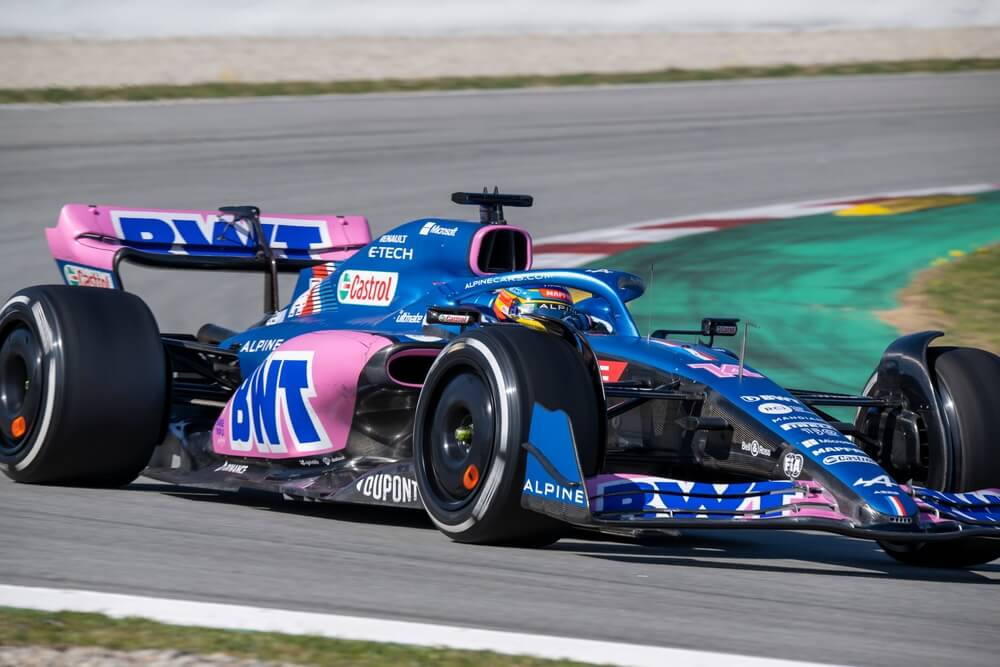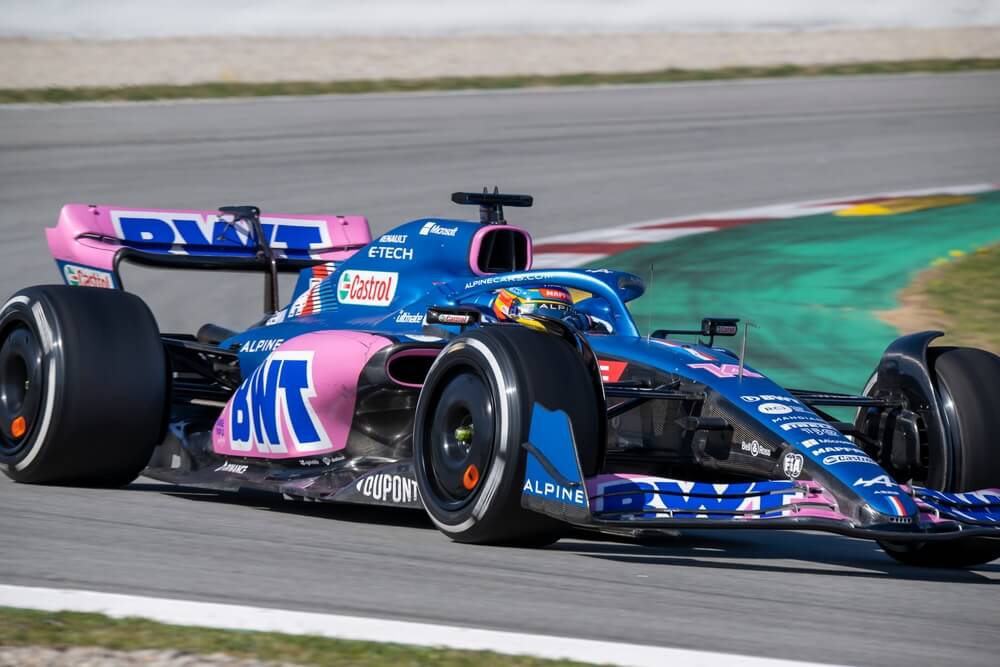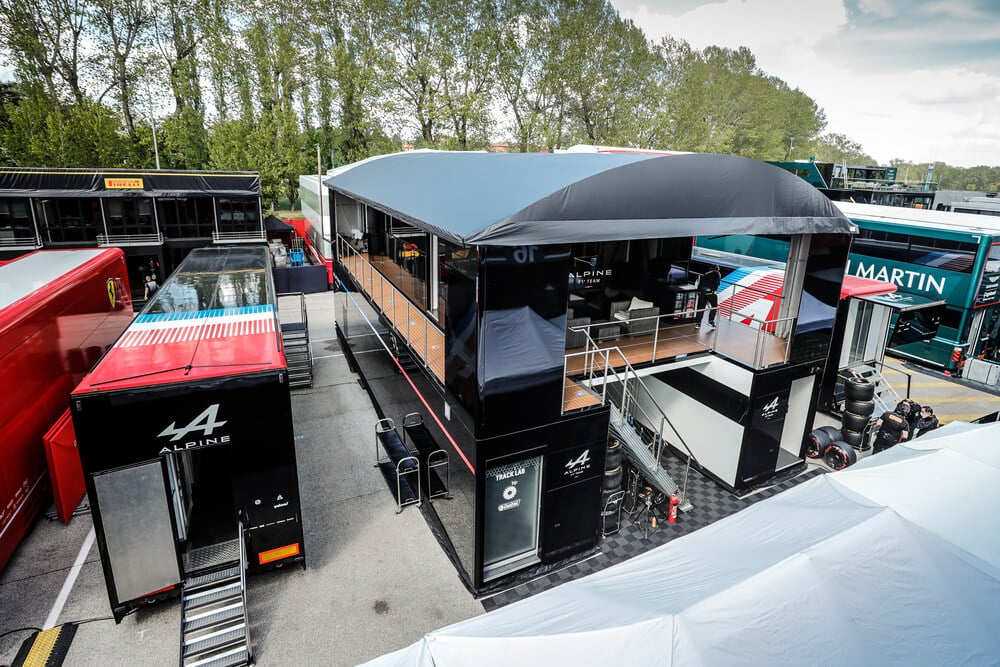The term ‘monocoque’ is derived from the French words ‘mono’ and ‘coque’, which literally translates to ‘single shell’. This is precisely what the monocoque design does – providing a single shell structure typically known as “survival cell” for Formula One cars.
It serves as an incredibly strong backbone, offering both protection and rigidity to the vehicle, allowing it to reach unprecedented speeds while maintaining safety standards. The monocoque is not only important when it comes to preventing fatal accidents in a high-speed environment, but it is also a key factor in the overall performance of F1 cars.
This article will take a look at the history and development of monocoque design, as well as its role in modern Formula One cars.
Table of Contents
Watch this video to learn more about the monocoque in F1.
Evolution of Monocoque Design in Formula One
F1 has always been a technology-driven sport, and the evolution of its cars is no exception. Where there was once a reliance on steel and aluminum structures, the introduction of monocoque construction changed the game. This revolutionary design provided more speed, efficiency, and protection than ever before – which is why it quickly became the backbone of F1 cars. With its sleek yet sturdy form, monocoque represents an important milestone in Formula One racing history. Its impact was immediate and far-reaching, transforming the sport as we know it today.
Let’s take a closer look at the evolution of monocoque design.
The Early Years: Steel and Aluminum Structures (1950s-1960s)
In the early days of Formula One, steel and aluminum structures were employed for car designs due to their desired strength-to-weight ratio. But as speeds increased, the limitations of these materials became apparent – they lacked rigidity and added unnecessary weight to cars. This was not ideal for the high-speed demands of racing, leading engineers to search for a better solution.
The Tubular Spaceframe Era (Late 1950s-1960s)
The late 1950s saw the introduction of a revolutionary design: the tubular spaceframe chassis. This revolutionary concept comprised of light, small tubes that were carefully arranged in geometric patterns to create a structure that was both strong and lightweight.
Unfortunately, the spaceframe couldn’t distribute forces throughout its body evenly, making it considerably less safe in high-speed collisions. Despite this drawback, the tubular spaceframe allowed for greater advances in racing technology than ever before, and was adopted by many of the top teams in Formula One.
Transition to Monocoque Construction (1960s onwards)
In the early 1960s, Formula One design underwent a revolutionary shift with the advent of monocoque construction. The Lotus 25, designed by Colin Chapman and launched in 1962, was the first F1 car to make full use of this new technique. Chapman’s decision to incorporate a monocoque chassis had a major impact on F1, as it enabled the car to be lighter and more aerodynamic.
With the dawn of the monocoque design, a wide range of materials began to be utilized. Carbon fiber and Kevlar were first employed in the 1970s, quickly becoming the new go-to for a strong yet lightweight framework that could handle extreme forces during races or collisions. These materials provided an unbeatable strength-to-weight ratio which allowed Formula One cars to reach incredible speeds without sacrificing safety.
McLaren was the first to introduce monocoque construction with their MP4/1 model in 1981, revolutionizing the design and performance of Formula One cars. This method prioritized aerodynamics, safety, and weight reduction which has since become the standard when it comes to car design within the sport.
Anatomy of a Monocoque
The anatomy of a monocoque is what gives Formula One cars their performance, safety and efficiency. It ranges from primary load-bearing structures to complex electrical systems and cooling mechanisms. This assembly provides the car with a strong backbone to withstand the forces of a race track as well as seamlessly connecting all its essential components.
Let’s take a closer look at the features and parts that make up a monocoque.
Structural and Safety Components
At the center of the monocoque, lies the framework of the Formula One car, made from lightweight but sturdy materials that can handle the immense stresses experienced during racing. This ‘backbone’ carries not only the driver’s secure compartment (survival cell), but also vital components such as front and rear crash structures, to absorb impact energy in an accident.
In addition, the monocoque also features side structures which provide lateral protection against collisions, ensuring that drivers are kept safe in the event of a crash. Combined with an array of other safety components, like seat belts and headrests, these structural elements help keep Formula One cars as safe as possible for their drivers.
Integration of Functional and Operational Systems
The monocoque chassis forms the essential backbone of a Formula One car, but what makes it so special is its ability to integrate all the necessary functional and operational systems. This includes steering, throttle, brake controls, telemetry systems and even the fuel cell – designed for both safety and lightweight purposes.
All this is done in an elegant manner that allows for maximum resilience against punctures and other external damage. This integration of functional and operational systems is what gives Formula One cars their edge over their competitors. With a monocoque chassis, they can not only be lighter, but also reliable and robust in the process.
Suspension, Cooling, and Electrical Arrangements
The monocoque design of a car is more than just an attractive exterior; it also includes essential systems such as suspension, cooling, and electrical arrangements for optimal performance.
The suspension system helps to provide the vehicle with comfort while driving, allowing for a smooth ride. Cooling systems are important in regulating temperatures within the car, ensuring that all components stay at their desired temperature. The electrical system works to provide the power needed for accessories, such as headlights and the radio, while also helping to maintain the car’s overall performance. All these systems work together in harmony to ensure a pleasant driving experience.
Material Selection in Monocoque Construction
When building a monocoque, it’s important to select the right materials in order to ensure optimal performance, maximum safety and compliance with regulations. In the past, aluminum alloys were commonly used for this type of construction; however, advances in material technology have enabled the use of more modern composite materials.
Let’s take a closer look at material selection in monocoque construction:
Historical Materials and Aluminum Alloys
In the past, aluminum alloys were a primary choice when it came to materials used in monocoques, as they offered superior rigidity compared to their tubular predecessors. Thanks to their accessibility, malleability and reasonable weight-to-strength ratio, aluminum alloys continued to be the material of choice until the early 1970s.
However, limitations such as limited absolute strength and energy absorption caused them to be superseded by more innovative materials such as composite laminates.
Transition to Composite Materials
The late 1970s and early 1980s saw a major shift in the materials used for Formula One construction. Carbon fiber composites and Kevlar, two materials with superior strength, rigidity, and crash energy absorption properties compared to aluminum alloys, began to be used for the construction of race cars. Though initially expensive due to their advanced manufacturing techniques required, these materials were favored for their light weight and impact resistance which helped ensure the safety of drivers on the track.
The transition to composite materials also revolutionized the design of Formula One race cars, as aerodynamic shapes and downforce could now be generated with greater accuracy. This enabled engineers to develop complex structures that improved the car’s performance significantly over the course of a race. In addition, composite materials allowed for the creation of lighter and stronger components that could be used in the construction of a car, making it easier for teams to improve its performance.
Manufacturing Techniques for Monocoques
Manufacturing monocoque chassis requires extreme precision and is accomplished through a variety of methods – each with its own set of advantages and drawbacks. Let’s delve into some of the techniques that have shaped monocoque construction, including hand-laid construction, autoclave curing, resin transfer molding (RTM), and automated processes.
Hand-laid construction
Hand-laid construction is a laborious process that involves layering fiberglass or other composite materials saturated with resin on a mold by hand. Each layer is carefully placed to ensure the fibers are in perfect alignment, offering maximum strength. Although this method takes time and requires experienced artisans for a superior finish, it can be prone to human error which makes it impractical for mass production.
In the end, however, hand-laid construction produces a product with superior strength and outstanding quality that is second to none. This unique technique offers incredible durability and performance that will last for years to come. The final result is a stunningly crafted item made with integrity and precision that stands out from the rest.
Autoclave curing
Another method for creating carbon fiber monocoques is Autoclave Curing. This method of construction involves placing the hand-laid composite in a specialized oven, an autoclave, and exposing it to both heat and pressure. This process allows the resin to cure and solidify the structure, providing an even, strong, and high-quality finish.
Although this method is more costly and requires access to an autoclave, the results are worth it. The incredible strength and durability makes autoclave curing one of the most sought-after methods for creating carbon fiber composites. It’s a great way to ensure that your product will stand up to even the harshest conditions.
Resin transfer molding (RTM)
Another way to produce parts that require a high-quality finish is Resin Transfer Molding (RTM). This process involves placing dry fibers into a mold and injecting resin into it with pressure to create an even, reliable mixture of resin and fiber.
Additionally, this method offers the ability to incorporate cores or inserts within the mold for more specialized shapes. Although it can be more expensive, RTM has the advantage of precise resin flow control so that voids and parts with low fiber content are avoided. This makes it a viable option for areas that require an increased level of detail, accuracy and strength like monocoque.
Continuous fiber layup techniques
Continuous fiber layup and automated processes are increasingly being used in the production of Formula One monocoques, driving further advancements in performance and safety.
This technology enables the precise placement of fibers, allowing for increased strength and improved performance compared to traditional layup techniques. However, such machinery is expensive and requires complex programming, making it a challenge to implement in production.
Despite this, the potential benefits of continuous fiber layup and automated processes make it an increasingly attractive option for Formula One teams looking to gain that extra edge on the track. With their ability to reduce labor costs and increase efficiency, these technologies are sure to become more commonplace in F1 monocoque production in future seasons.

Safety Considerations in Monocoque Design
Now that materials and processes have been discussed, attention must also be paid to the safety concerns that arise when constructing a monocoque chassis. Due to their complex nature, these components must meet strict FIA safety regulations in order for them to be used on the track.
Let’s take a closer look at the safety considerations that are taken into account when designing a monocoque chassis.
Structural integrity and crashworthiness
The first thing that comes to mind when talking about a monocoque is its structural integrity and crashworthiness. A monocoque’s design must be able to withstand the rigors of racing conditions, while also protecting the driver in case of a collision.
To ensure this, composite materials like carbon fiber and Kevlar are used to reinforce the structure and absorb energy during an impact, making a monocoque highly crash-resistant. This ability to absorb energy helps protect the driver and makes it a reliable choice for racing drivers.
Energy absorption and dissipation mechanisms
Another important component of a monocoque’s construction is its energy absorption and dissipation mechanisms. These features are built into the front and rear crash structures, which deform upon impact to absorb the energy created by a collision. This helps protect the driver from the force of an accident.
Similarly, side structures are designed for lateral collisions and made with materials that can effectively dissipate the energy of an impact. All of these structures are essential for keeping drivers and their passengers safe in the event of a crash.
Role of the survival cell in driver protection
The survival cell serves as the driver’s cockpit and is an essential safety element of the monocoque. It provides robust protection against high impact, while also offering an escape route if ever needed. Extensive tests are conducted to ensure it meets the FIA’s exacting standards. This feature is integral in providing superior driver safety and security.
Impact of FIA regulations on safety advancements
The FIA regulations have had a profound impact on the advancement of safety in motorsport. Strict safety standards and testing procedures for the monocoque structure of Formula One cars have led to stronger, more energy-absorbent designs that offer drivers unprecedented levels of protection.
For example, in the early years of the sport, no one could have dreamed of the kinds of injuries drivers can now sustain without suffering serious harm. Thanks to FIA regulations, motorsport safety has come a long way since then and continues to improve with each passing year.
The crash test requirements for Formula One cars have also been tightened up over the years. This has led to cars that are much more resistant to impact and better able to protect drivers in the event of a crash, resulting in fewer fatalities due to accidents.
Monocoque Maintenance and Repair
Monocoque Maintenance and Repair is a delicate yet complex operation in Formula One. Unique inspection processes, specialized repair methods, and sophisticated non-destructive tests are necessary to ensure the safety of drivers and cars.
Let’s take a closer look at how this intricate and crucial task is done.
Inspection and maintenance procedures
Given the intense conditions a Formula One car must withstand, inspection and maintenance of the monocoque are essential. After each race, an exhaustive assessment is conducted to detect any damage or deterioration.
This includes a thorough visual analysis of the chassis for any cracks or distortions, as well as an inspection of all its connectors and attachments for evidence of strain or malfunction. Regular maintenance ensures the safety and performance of Formula One cars.
Structural repairs and reinforcements
Structural repairs and reinforcements are necessary when damage to a monocoque is detected. Carbon fiber repairs are the most common form of repair and involve removing damaged material, replacing it with new carbon fiber layers, and curing it to create a solid repair.
As monocoques have complex shapes and structures, these repairs can be difficult to execute correctly. The skills of experienced technicians are required to ensure the paramount importance of safety and performance is maintained when making structural repairs and reinforcements.
Challenges and considerations in repair work
The repair of a monocoque presents several difficulties. Accessing the damaged section can be troublesome due to its complex design. Keeping the structure intact during repair is a fundamental concern that demands thorough planning and implementation.
Additionally, any repairs or reinforcements must abide by FIA regulations, resulting in extra layers of complexity. Therefore, it is essential to carefully consider the challenges and considerations when undertaking monocoque repair work.
Role of non-destructive testing (NDT) techniques
Non-Destructive Testing (NDT) techniques are essential for the safety and performance of Formula One cars. These methods enable a thorough examination of the monocoque without causing any additional harm, allowing any potential problems to be identified and rectified before the vehicle is back on the track. By using NDT inspection techniques, Formula One teams can ensure that their cars are always race-ready and safe.
In a sport where every split second counts, the non-invasive and reliable nature of NDT methods make them invaluable in helping to keep F1 vehicles running at peak performance. By regularly employing NDT testing methods, teams can easily identify any underlying issues that could otherwise turn into larger problems in the future, while also having the opportunity to make any necessary repairs or modifications.
In addition, NDT techniques can be used to test parts and components before they are fitted on a car for race day, which helps to ensure that teams have the best possible chance of success on the track.
Frequently Asked questions
How does the monocoque contribute to driver safety?
How are monocoques inspected and repaired?
Why are materials like carbon fiber and Kevlar used in monocoque construction?
Conclusion
So, there you have it – the monocoque is an essential part of a Formula One car and its construction requires great expertise. From the material selection to the curing process and non-destructive testing, every step must be carefully monitored in order to ensure that the structure can withstand both high speeds and impacts.
By using lightweight yet strong materials like carbon fiber and Kevlar, engineers can ensure that their cars are safe for drivers, yet fast enough to win races. Thanks to the monocoque, modern Formula One cars have become faster than ever before.
Article sources
Learn more about Formula One
Want to learn more about F1? Then visit our Formula 1 glossary and dictionary.



